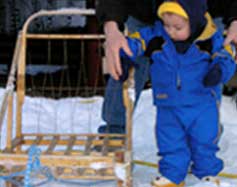Alaska:

Village Life
Land-based living, whether for spiritual, cultural, or the most basic necessity of nutritional survival reasons,
have prevailed historically in Alaska. Traditional nomadic ways of life ceased to exist with the onset of
Western influence. The end of this nomadic lifestyle, however, did not bring an end to established natural
resource harvesting practices. Rural Alaskans, primarily Alaska Natives, still depend greatly on the land's
readily available wildlife and plant resources. For some villages, locally harvested resources make up more
than half of the average daily consumption. This ancient way of life is also deeply embedded in the residents'
emotional relationship to the land. Alaska Natives maintain cultural identity and survival through connections
to the land and the natural resources of their surroundings.
Rural Alaska depends on a cash-based system combined with natural resource harvesting, allowing Alaskan villages
to survive. Generally incomes are low and prices are high in these communities. For example, a gallon of milk
that costs $3.50 in Alaska's city of Anchorage can cost $10.00 in a remote village. In addition, the 2005 per
capita income in the Anchorage MatSu area was $38,421 compared to $25,674 in the Yukon-Koyukuk census area
(Alaska Dept. of Labor & Workforce Development, 2005). The unemployment rate must also be considered-the
current unemployment rate in Anchorage is 5.7% compared to 16.4% in the Yukon-Koyukuk area (Alaska Dept. of
Labor & Workforce Development, 2008). In order to hunt, fish, or gather legally in Alaska, supplies, permits
and fossil fuels are necessary; thus employment is required to subsidize traditional natural resource harvesting
practices in rural Alaska.
For more information please contact: